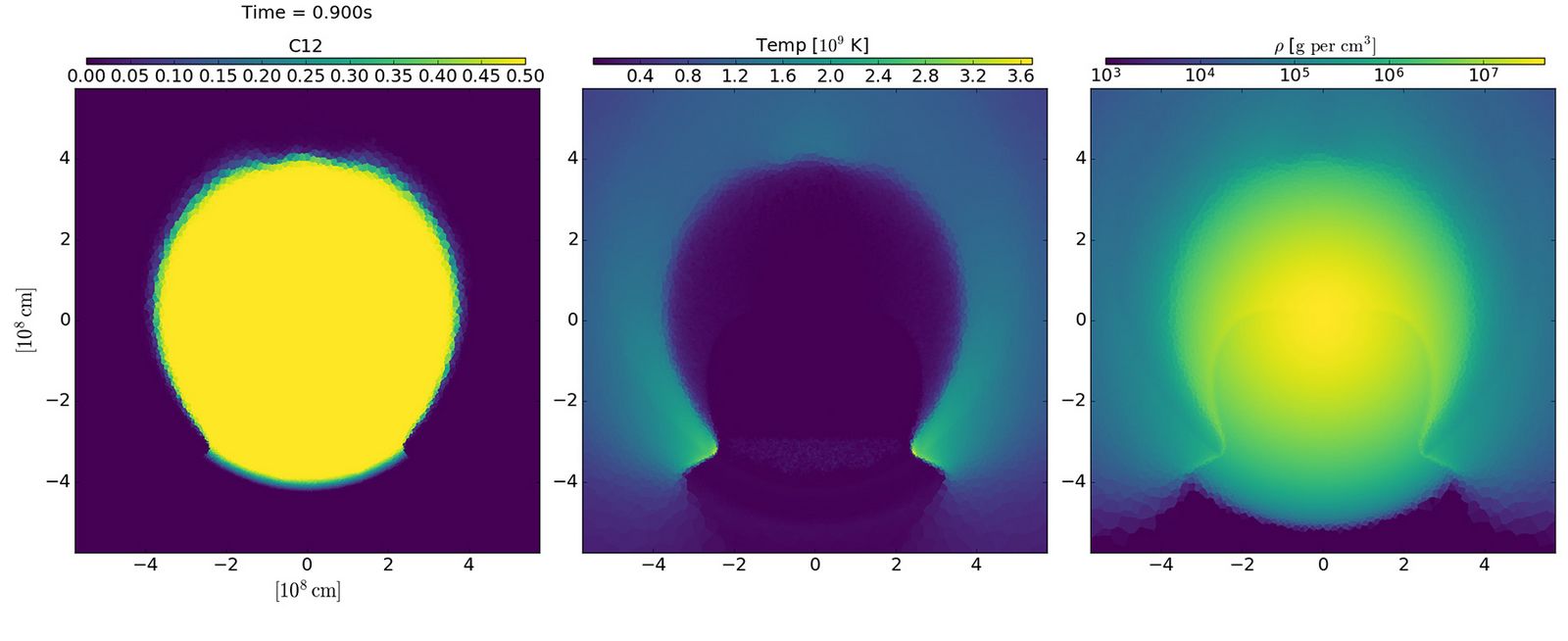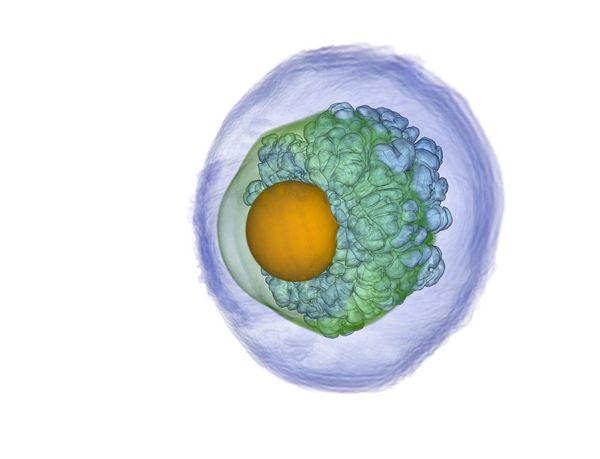ASTROPHYSICS
Progenitor Systems of Thermonuclear Supernovae
Principal Investigator:
Wolfgang Hillebrandt
Affiliation:
Max-Planck-Institut für Astrophysik, Garching b. München
Local Project ID:
hmu14
HPC Platform used:
JUWELS of JSC
Date published:
Supernovae are cataclysmic explosions of stars at the end of their evolution. These events occur frequently in the Universe. They are important for the evolution of galaxies because they inject energy as well as heavy elements produced during the explosion into the interstellar medium from which new stars form.
Project HMU14 is dedicated to a special class of supernovae, the so-called Type Ia supernovae. These objects serve as distance indicators in cosmological surveys and have led to the discovery of the accelerated expansion of the Universe (Nobel Prize in Physics 2011). They are believed to originate from the thermonuclear disruption of a white dwarf star consisting mainly of carbon and oxygen. Despite their outstanding importance for astrophysics and cosmology the details of the explosion mechanism remain enigmatic. Prolific observational campaigns carried out over the past decades produced a wealth of high-quality data, yet the progenitor system and the exact explosion mechanism are still unknown. Theoretical input is certainly a key to make progress in understanding these astronomical events. With extensive numerical simulations, Project HMU14 contributes to these efforts.
A fundamental question that decides on how the explosion triggers and proceeds physically concerns the mass of the white dwarf at the onset of the supernova event. These objects of about the size of the Earth are extremely dense so that their masses amount to that of the Sun – or even more. The limit of their stability is reached at the so-called Chandrasekhar mass of about 1.4 solar masses. Project HMU14 explores how expected observational features depend on whether the supernova explosion triggers at the Chandrasekhar mass or below it.
A potential mechanism for triggering an explosion of a sub-Chandrasekhar mass white dwarf is the so-called double detonation scenario. Here, helium is accreted from a binary companion (either a He star or He white dwarf) star that interacts with the white dwarf. Once a sufficient mass of helium has been accreted and piled up on the surface of the white dwarf, it is expected that critical conditions for a He detonation arise. In project HMU14, we simulate the propagation of a detonation wave through the He shell with the moving-mesh hydrodynamics code AREPO (Springel 2010).

Figure 1. © MPA Garching
This is illustrated in Figure 1 which shows a central slice through the 3D stellar structure. The carbon abundance indicating the white dwarf core is color-coded in the left panel. An increased temperature in middle panel of Figure 1 indicates where the detonation burns the helium shell. This detonation drives a shock wave into the core that is clearly observed as an increase in density (right panel of Figure 1). This shock wave ignites a second detonation in the carbon/oxygen material thus leading to a supernova explosion. Our full 3D simulations show a carbon ignition mechanism that received only little attention before: The convergence of the He detonation wave at the antipode of the He ignition spot is strong enough to ignite a carbon detonation. This can be seen in the animation.
mp4 Video © MPA Garching
Follow-up simulations with the radiative transfer code ARTIS (Sim 2007; Kromer & Sim 2009) allow us to predict observables from the hydrodynamic explosion model. In the current choice of parameters, strong features originating from the ashes of the primary He shell detonation in the outer layers of the ejected material are in conflict with observations of Type Ia supernovae. An ongoing parameter study will determine whether this is a general problem for the scenario or whether it has potential to explain a significant fraction of the observed events.
The second progenitor scenario currently under investigation in project HMU14 concerns a carbon/oxygen white dwarf star approaching the Chandrasekhar mass limit due to accretion of hydrogen or helium-rich material from a companion star in a binary system. In this slow process, the accreted material can be processed by nuclear burning so that the overall mass of the carbon/oxygen white dwarf increases steadily. Once it comes close to the limiting Chandrasekhar mass, the central density increases rapidly and a thermonuclear runaway ignites explosive thermonuclear burning close to the center of the star. We model the propagation of the ensuing burning front as a slow, sub-sonic process – a thermonuclear flame burning carbon and oxygen to heavier nuclei such as silicon and nickel. If the flame is ignited in a few spots only, the WD is not fully disrupted and the explosion leaves behind a bound remnant. It has been shown by Kromer et al. 2013 that this explosion scenario is able to explain the basic characteristics of as specific, rather faint sub-class of Type Ia supernovae, the so-called Type Iax supernovae.
Figure 2 shows the flame 1.35s after its ignition in one of our simulations. It first burns to the surface of the WD (asymmetric ignition) and then wraps around the core (orange). The details of the initial setup, i.e. the ignition location, the number of ignition sparks, the central density etc., have a crucial impact on the details of the explosion. Therefore, this parameter space is currently being studied with a series explosion simulations followed by radiative transfer calculations to predict observables. Our goal is to determine to which extend the scenario can explain the full observed range of properties of Type Iax supernovae.
These two examples demonstrate the power of a consistent multidimensional simulation pipeline that allows to assess the validity of Type Ia supernova models. This pipeline was developed by an international team including researchers from the Max Planck Institute for Astrophysics, Garching, Germany, from Heidelberg University and the Heidelberg Institute for Theoretical Studies, and from Queen’s University Belfast. In a joint effort, members of these groups perform extensive simulations within project HMU14 to decipher the physical nature of Type Ia supernovae.
Project contributors
Prof. Dr. Friedrich Röpke, Dr. Markus Kromer, Dr. Rüdiger Pakmor, Dr. Stuart Sim, Dr. Luke Shingles, Christine Collins, Sabrina Gronow, Florian Lach and Prof. Dr. Wolfgang Hillebrandt (PI)
Scientific Contact
Friedrich Röpke
Professor of Theoretical Astrophysics, Zentrum für Astronomie der Universität Heidelberg
Group Leader, Physics of Stellar Objects, Heidelberg Institute for Theoretical Studies (HITS)
Heidelberger Institut für Theoretische Studien
HITS gGmbH
Schloss-Wolfsbrunnenweg 35, D-69118 Heidelberg (Germany)
http://www.h-its.org
e-mail: friedrich.roepke@h-its.org
http://www.h-its.org/pso
JSC project ID: chmu14
December 2019
